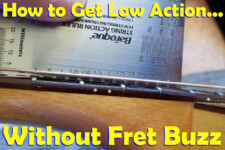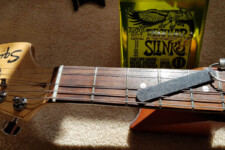Why Does My Guitar Sound Bad When I Play Chords?
There can be a number of reasons why your guitar doesn’t sound good when playing chords. The problem can be either your guitar, or your technique.
Bad sounding chords can be caused by old strings, bad tuning or intonation, fretboard problems, bridge problems – or simply the way you are fretting the chords.
The good news is you can fix the problem once you know what it is, and in a short time have your chords sounding a lot sweeter.

Why Your Guitar Chords Sound Bad – Playing Tips
As long as your guitar strings are in reasonable condition, and your guitar is tuned (see the guitar section below for that info), you should be able to make a chord sound good.
Fretting Tips
1) Test Each Note
Hold the chord you want to play with you fretting hand, and then pluck each string one at a time from the low to the high string. If you hear muted and/or buzzing strings, then you need to adjust the way you fret the chord.
2) Muted Strings
If you are getting muted strings, then check you are holding the strings with enough pressure (not too much though). Then check each finger tip carefully to see if the fleshy part of a finger is accidentally touching another string.
If the fleshy part of a finger is touching the string below it, then you need to move your thumb down the neck a little. This will help your fingers to touch the strings at a better angle, moving the fleshy parts away from the other strings.
You can also get muted strings when your thumb is too high on the neck, or flat against the neck pointing at the tuners. This causes your hand to sit too close to the fretboard.
3) Buzzing Strings
If your fingers are touching each string on your fingertip and other strings are clear, then make sure each finger is holding the string near the fret. Each fingertip should be as close to the fret as possible without being on top of it.
You can also get buzzing strings when you hold the strings with too little pressure, causing string rattle on the frets. This can be a big problem when first learning barre chords, as you need more finger strength to hold down 3 or more strings with one finger.
Sometimes you can just adjust your finger position slightly to fix the problem, or just keep trying for a couple of weeks until your hand becomes stronger.
4) Too Much Pressure
This is especially a problem for learners who have an electric guitar, as the strings are thinner than acoustic guitars, and are easy to hold with too much force.
Holding the strings too hard will make the notes sound sharp, and a few sharp notes payed at the same time sounds really bad. Try pressing the strings a little softer, but if you get buzzing then it is too soft.
Strumming Tips
An experienced guitar player can make a simple chord sound great, and the secret is knowing how to vary their strumming pressure, and how to strum rhythms with good timing.
You will also find that chords often sound best when you focus on strumming different strings for up and down strokes. Try to strike the lower strings on down strokes and higher strings on up strokes, and you will get more character in your sound.
These are things you can practice to make your chords sound even better, and it’s worth spending time learning some solid basic strumming patterns, and keeping in time.
Why Your Guitar Chords Sound Bad – The Guitar
When you’re sure your playing technique is good and not causing bad sounding guitar chords, then it’s time to check your guitar for problems.
Old Guitar Strings
This is probably the number one reason for a guitar to sound bad, as we all leave strings longer than we should. If you can’t remember when you last changed your guitar strings, then it’s time to do it now!
Looking at your strings, make sure they don’t have the following problems:
- Dark sections on the strings.
- Broken outer winding.
- Shiny flat spots where the frets are.
- Visible dust and grime.
- Rust.
- Generally dull looking.
Electric guitar strings are normally a shiny steel color, acoustic guitars are either a copper or yellow-bronze color, and nylon classical guitar strings will have 3 clear strings.
If your strings look quite shiny near the tuning posts but dull where you play them, it’s probably time for a string change. Strings don’t have to be expensive to sound good, and it’s a good idea to get used to changing them 2 or 3 times a year to keep your guitar sounding good.
Bad Tuning or Intonation
1) Winding the Strings Correctly
If your strings are not wound on the tuning pegs correctly, then they can slip while you play and go out of tune very quickly. This can also happen with nylon strings at the bridge, as they are tied into place.
2) Tuning Pegs
Sometimes old tuning pegs get loose, worn out, broken, or just hard to turn. This makes it very difficult to tune a guitar correctly, and sometimes impossible. Loosen the string tension off each tuner a little, and check that the tuners turn easily without any notchiness.
Some open gear tuning pegs can be fixed with some lubricant, for others you will need to open them up to fix them, or sometimes have them replaced.
3) Tuner & Tuning Technique
Electronic tuners are very accurate, with even free mobile app tuners being plenty accurate enough for most people’s ears.
Check that you have your tuner set for 440Hz (standard C tuning), and that it is also set for chromatic tuning. Some tuners have many options, and you could find your tuner was set for open tuning, half step down tuning, or something else that isn’t standard.
As you tune up a string (especially the thick strings), it can change the tension and tuning of the other strings. Tune your guitar strings from low E through to high E, and then check and fine-tune all six strings again one or two times.
4) Check The Intonation
A guitar with good intonation will have notes that sound close to perfect on each string and at each fret. No guitar is perfect, however poor intonation can make one string sound sharp while another sounds flat.
Intonation can be adjusted at the bridge on electric guitars, and is done by changing the string length between the nut and bridge. Acoustic guitars are more difficult to intonate correctly, as the saddle needs to be adjusted.
Use your chromatic tuner to check that each string is still in tune at the 12th fret. If you find the open string tuning is different to the note at the 12th fret, then your intonation may need to be improved to make your guitar chords sound right.
Action & Fretboard Problems
The action of a guitar refers to how high the strings are from the frets.
- If the action is too high at the nut, you will get sharp sounding notes at the first few frets, and chords will sound bad as a result.
- If the action is too low at the nut, then you will get fret buzz at the first fret, and will result in buzzy-sounding open chords.
- If the action is high and the neck has too much relief (back bow), then notes can sound sharp in many places on the neck, resulting in poor sounding chords.
- If the action is too low (usually on poorly set up electric guitars), then you can get fret buzz at many places on the neck, making chords and single notes sound bad.
Aging guitars all have fret wear, and as frets wear down in places you will find chords and notes at some places will sound bad due to muted or buzzy strings.
Low action combined with fret wear are a recipe for bad sounding chords, and it’s best to have a professional guitar tech check your guitar if you think this might be the cause of your problems.




